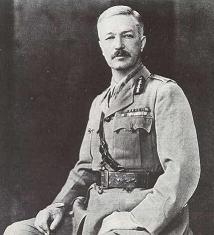Reginald Dyer facts for kids
Quick facts for kids
Reginald Edward Harry Dyer
|
|
|---|---|

Dyer circa 1919
|
|
| Nickname(s) | The Butcher of Amritsar |
| Born | 9 October 1864 Murree, Punjab, British India |
| Died | 24 July 1927 (aged 62) Long Ashton, Somerset, England |
| Allegiance | British Empire |
| Service/ |
British Army Bengal Army Indian Army |
| Years of service | 1885–1920 |
| Rank | Colonel (Formal Rank) Brigadier General (Field Promotion) |
| Commands held | Seistan Force 25th Punjabis |
| Battles/wars | Third Anglo-Burmese War Chitral Expedition First World War |
| Awards | Companion of the Order of the Bath Mentioned in Despatches (2) |
| Spouse(s) | Frances Anne Trevor Ommaney (m. 1888-1927 his death) |
| Children | Gladys Mary b. 1889 Ivon Reginald, b. 1895 Geoffrey Edward MacLeod, b. 1896 |
Reginald Edward Harry Dyer was a British Indian Army officer. He is mainly remembered for his role in the Jallianwala Bagh massacre in 1919. This event happened in Amritsar, India.
Contents
Who Was Reginald Dyer?
Reginald Dyer was born on October 9, 1864, in Murree, which was then part of British India. Today, Murree is in Pakistan. He spent his early years in Shimla, India, and went to school there. He was born a few years after the Indian Rebellion of 1857. This rebellion was a fight by some Indians against British rule. Even though the British won, the rebellion caused a lot of distrust between British people and Indians. This tension affected Dyer's life and career.
Early Life and Military Career
Dyer went to college in Ireland before joining the British Army in 1885. He became a Lieutenant. Early in his career, he helped control riots in Belfast. He also fought in the Third Anglo-Burmese War.
Later, he joined the British Indian Army. He fought in several campaigns, including the Black Mountain campaign in 1888 and the battle of Chitral in 1895. He was promoted to Captain in 1896.
Dyer continued to rise in the army. He became a Lieutenant-Colonel in 1910. During World War I (1914–1918), he was in charge of a force called the Seistan Force. He was also given an award called the Companion of the Bath (CB). By 1916, he was a temporary Brigadier-General. He retired from the army on July 17, 1920, as a Colonel.
Tensions in India (1919)
In 1919, people in the Punjab region of India were worried about British rule. There were fears of a rebellion against the British. Sir Michael O'Dwyer, who was the Lieutenant-Governor of Punjab, decided to remove Indian leaders who were protesting.
Two of these leaders were Dr. Satyapal and Dr. Kitchlew. They both believed in peaceful protest. They were arrested because British officials thought they might cause trouble.
Their arrest led to many protests. Crowds gathered in public places, asking for the two men to be released. Soldiers fired at a crowd on a bridge, which caused some deaths. This made the crowds even angrier.
Some groups of people in the city started looking for Europeans. On April 9, 1919, Miss Marcella Sherwood, a school teacher, was attacked and hurt by a crowd. She was saved by local Indians who hid her. This attack made Brigadier Dyer, who was in command of troops nearby, very angry.
The Amritsar Massacre
Brigadier Dyer is most known for what he did on April 13, 1919, in Amritsar. This event is called the Jallianwala Bagh massacre.
What Happened at Jallianwala Bagh?
On that day, many unarmed people, including women and children, had gathered at a place called Jallianwala Bagh. They were there to celebrate Vaisakhi, which is an important religious and cultural festival.
Jallianwala Bagh was a large area with walls all around it. It had only a few small entrances. Brigadier Dyer arrived with 90 soldiers. These soldiers were armed with rifles. Dyer ordered his troops to fire directly into the crowd. They kept shooting until they ran out of bullets, firing 1650 rounds in about 10 minutes.
During the shooting, Dyer watched his troops. He told them to shoot where most people were gathered. He later said he did this to "punish them" for being there. He admitted that the crowd was not given any warning to leave. He also said he did not feel sorry for ordering the shooting.
How Many Were Hurt or Killed?
The British army reported 379 people died. However, other reports suggest the number was much higher, possibly over 1,000 dead and more than 1,200 wounded. Because so many people were killed and hurt, Brigadier Dyer became known as "The Butcher of Amritsar" in India.
The "Crawling Order"
After the massacre, Brigadier Dyer sent soldiers to the street where Miss Marcella Sherwood had been attacked. He ordered that any Indian person wanting to go through that street had to crawl on their hands and knees. This order also applied to the people who had rescued Miss Sherwood.
Because of this order, the street was closed. People living in houses there could not leave easily. No doctors or supplies were allowed in, so sick people could not get help. This order was enforced by a place where people were punished in the middle of the street.
Later Life and Death
After the Amritsar massacre, Dyer's health became poor. In 1921, he suffered from paralysis. He never fully recovered. He died on July 23, 1927, near Bristol, England.
After his death, some newspapers praised him, calling him "The Man Who Saved India." However, others strongly disagreed. The Westminster Gazette wrote that no British action in India had hurt Indian faith in British justice more than the Amritsar massacre.
Images for kids
See also
 In Spanish: Reginald Dyer para niños
In Spanish: Reginald Dyer para niños

